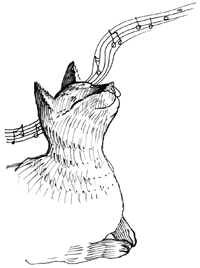STRANGE BUT TRUE- Caterwauling: Music soothes savage beasts

DRAWING BY DEBORAH DERR McCLINTOCK
Q. What does your dog or cat think of the music you play? –L. Stuart
A. It's not clear if animals actually "listen," but they do seem affected by the general tone, says Tufts University's Nicholas Dodman, author of Dogs Behaving Badly and The Cat Who Cried for Help. Background radio is often prescribed for pets with separation anxiety, serving perhaps as "white noise" masking disturbing sounds.
Can cats or dogs recognize particular tunes? Doubtful, but angry music (heavy metal) apparently disturbs some, and what we consider soothing music will more likely placate. Cows have been found to produce more milk when country music fills the milking parlor, leading Hoard's Dairyman to declare, "Moosic is good for cows."
Few studies have been done, but one woman describes calming her cats in the car with operatic tapes. "But if I play Joan Baez, the Eagles or just about anything else, they yowl all the way. Toby especially doesn't like Vanilla Fudge." Once when the woman sang off-key at home, Toby put paws over her mouth, then fled the room.
Q. What's there to say about a bottle of beer that nobody– drunk or sober– ever told you before? –S. Adams
A. Try this: When you pop the cap, carbon dioxide molecules shoot out the bottleneck at rifle-bullet speeds, says Craig F. Bohren in Clouds in a Glass of Beer.
Or this: The racing molecules leave behind the more sluggish ones, creating a bottleneck zone where temperatures plunge to -30 degrees F., triggering condensation and the wispy vaporous beer clouds well-known to elbow-benders.
Also, beer is generally bottled under 30 to 45 p.s.i., which is what holds in the fizz and engenders the opening "pop." But what if someone shook the bottle long and hard beforehand? Wouldn't it eventually explode?
No, you can shake and shake until the cows stagger home, but you won't add any gas, hence no extra pressure and no bottle blast. All that happens is the agitated gas mixes with the liquid more thoroughly and drags a lot along upon uncapping. (Got a mop handy?)
Q. Using telekinesis to fetch an object from across the room would sure beat getting up out of your chair. Is this sort of mind-over-matter theoretically possible? –C.T. Magnificent
A. In the movie Phenomenon, John Travolta witnesses a mysterious flash in the sky, then finds himself growing smarter and smarter until at a doctor's office he demonstrates he can make a pen slide across the desk just by mentally focusing on it.
Physicist Lawrence Krauss, author of Beyond Star Trek: Physics from Alien Invasions to the End of Time, calculates just what it would take to pull off such a flashy demo.
Assuming the pen weighs about 0.1 kilogram (4 ounces), to drag it across a desk in a second would require only about 1 watt of power. That's a trivial amount.
But telekinetic energy would presumably radiate outward like gravity or radio waves, weakening rapidly with distance. So to exert 1 watt of power on a pen pointing toward you at a distance of a meter, your head as source would have to radiate roughly 100,000 watts of power, or more than the output of most big-city radio stations!
Maybe Travolta used his towering intelligence to figure out how to extract this power from the space around his head. For it is one of the fascinating realizations of modern physics, says Krauss, that empty space is not really empty but probably has some energy in it.
How much energy? Going by maximum estimates, moving the pen would have necessitated Travolta mentally squeezing out the energy from 10 billion cubic meters of vacuum, or the space inside a cube 2 kilometers on a side.
The Force must have been with him.
#